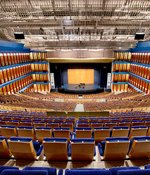
Tour: Prokofiev, Bartók, Dvořák
Kopatchinskaja, Fischer
Program
Featuring
Other information
The event is about 3.0 hours long.
About the event
The Budapest Festival Orchestra will bring a truly international repertoire of Russian, Hungarian and Czech music to the Basque Country. The concert opens with the orchestral version of Prokofiev’s chamber overture written for original Hebrew themes and concludes with one of the most famous pieces by Dvořák. Between the two, audiences can hear one of the most difficult instrumental pieces in the history of music, Bartók’s Violin Concerto No. 2 with Patricia Kopatchinskaja as the soloist, who is described by Iván Fischer as “ an extremely creative and sometimes provocatively original violinist with a unique imagination”. We may witness a special relationship between the soloist and the composition, since, as a critic for The Irish Times put it, the musician “makes her instrument sing, weep, dance, cajole, flirt....She plays the violin not really as an instrument, but as an extension of herself.”
For his own works, Prokofiev almost never used folk music melodies or those borrowed from other composers. This is why this overture, written for Hebrew themes, occupies such a special place in his oeuvre; it is more than a simple exercise in style. It is a rethinking of genuine Hebrew melodies. The composer was commissioned to write the piece in 1919 in the United States by clarinetist Simeon Bellison, who presented Prokofiev with a book of songs to serve as inspiration. Prokofiev rejected the request, but then fell in love with the world of the melodies after all. He sketched out the piece – originally conceived for the clarinet, a string quartet and the piano – in just one day, and then finalized it in less than two weeks. It presents and explores two themes in detail, evoking the world of the klezmer.
Bartók never made his early violin concerto public; still, the Violin Concerto he composed three decades after his early piece and which he considered his only one, is now commonly called the Second. He was commissioned by violinist Zoltán Székely in 1936 to compose a classic violin concerto. Bartók preferred a set of variations – the result being a three-movement piece presenting variations on the Hungarian folk song “Két szál pünkösdrózsa” (Two Peonies) throughout the movements. The first movement includes special violin techniques, a twelve-tone yet tonal theme, and quarter tones. The set of variations of the slow movement (measure: 9/8) contains elements of the verbunkos (a Hungarian dance) while the last part is a diabolical rondo that can be regarded as a free variation of the opening movement.
Many say Symphony No. 7 is Dvořák’s finest piece of music. After hearing Brahms’ Symphony No. 3, the composer decided to return to the genre following a hiatus of five years. “‘There is not a single superfluous note in the work,” he wrote to his publisher. The piece simultaneously features heated Czech political passions and the composer’s peaceful, harmonious love for his homeland. The unexpectedly quiet and lyrical opening of the first movement came to the composer at a train station in Prague: the slow movement represents Dvořák grieving for his mother, who had recently died, and for his eldest daughter, who passed away at a young age. After the vivacious yet melancholy scherzo, the piece concludes with an exotic finale.



